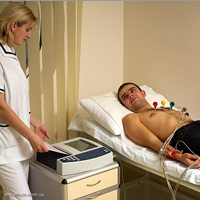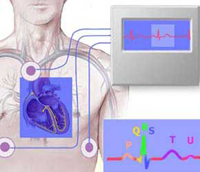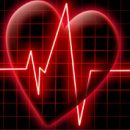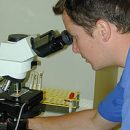With ischemic heart disease, the correct diagnosis is able to deliver only a cardiologist using modern diagnostic methods. Consider what methods help cardiologist.
Content
Diagnosis of Ischemic Heart Disease
 The correct diagnosis of ischemic heart disease is able to put only a cardiologist using modern diagnostic methods. In the 20th century, such a high percentage of death rate from IHS in the 20th century is partly due to the fact that due to the abundance of various symptoms and frequent cases of the asymptomatic treatment of IBS, the setting of the correct diagnosis was difficult. Nowadays, the cardiology has made a huge step forward in the methods of diagnosis of IBS. And there is every reason to assume that in the near future the problem will at least partially be solved. But the efforts of cardiologists for this is not enough. We talked about the symptoms of the IBS often begin to manifest itself in the form of subjective sensations of the patient, therefore, the earlier the patient will notice these feelings and turn to the cardiologist for diagnosis, the more likely to diagnose and begin the treatment in time.
The correct diagnosis of ischemic heart disease is able to put only a cardiologist using modern diagnostic methods. In the 20th century, such a high percentage of death rate from IHS in the 20th century is partly due to the fact that due to the abundance of various symptoms and frequent cases of the asymptomatic treatment of IBS, the setting of the correct diagnosis was difficult. Nowadays, the cardiology has made a huge step forward in the methods of diagnosis of IBS. And there is every reason to assume that in the near future the problem will at least partially be solved. But the efforts of cardiologists for this is not enough. We talked about the symptoms of the IBS often begin to manifest itself in the form of subjective sensations of the patient, therefore, the earlier the patient will notice these feelings and turn to the cardiologist for diagnosis, the more likely to diagnose and begin the treatment in time.
Of course, any diagnosis begins with a patient's survey. An experienced and knowledgeable cardiologist can say a lot about the patient even without using instrumental techniques. Therefore, before the examination at the cardiologist, the patient needs to recall all the sensations in the field of the heart, which he experiences and experienced, to determine, they changed or for a long time remained unchanged, whether he had such symptoms as shortness of breath, dizziness, reinforced heartbeat and T.D. In addition, a cardiologist's doctor may interest what diseases suffered a patient during life, what medications usually take and much more.
Much of valuable information can give the patient's inspection: when inspection, the cardiologist listens to possible noises in the heart, determines whether the patient has edema or sinuscia (symptoms of heart failure), often when inspecting, it is possible to establish the presence of arrhythmia.
During laboratory research, the level of cholesterol and blood sugar is determined, as well as enzymes that appear in the blood at heart attack and unstable angina.
Electrocardiography
One of the main methods for the diagnosis of all cardiovascular diseases, including IBS, is electrocardiography. The method of registration of an electrocardiogram is very widely used in cardiology diagnostics and is a mandatory stage in a patient examination, regardless of the preliminary diagnosis. ECG is used and with a dispensary examination, with prophylactic medical examinations, with exercise samples (for example, on a cyergometer). Therefore, we will repeat that subject to regular visits to the cardiologist for a preventive inspection, the patient has every chance to start the vital treatment of IBS in time. As for the ECG role in IBS recognition, this examination helps to detect deviations in the working conditions of the heart muscle, which may be crucial for the diagnosis of IBS.
Halter monitoring of electrocardiogram
 Halter monitoring of electrocardiogram – This is a long, more often daily registration of ECG, which is carried out offline in hospital or outpatient. At the same time, the conditions for conducting the survey must be as close as possible to the daily life of the patient, both at rest and during a variety of physical and psychological loads. This allows you to register not only the symptoms of the IBS, but also the conditions, the causes of their occurrence (at rest, under load). It is clear that the latter is especially important for examination of patients with the attacks of angina.
Halter monitoring of electrocardiogram – This is a long, more often daily registration of ECG, which is carried out offline in hospital or outpatient. At the same time, the conditions for conducting the survey must be as close as possible to the daily life of the patient, both at rest and during a variety of physical and psychological loads. This allows you to register not only the symptoms of the IBS, but also the conditions, the causes of their occurrence (at rest, under load). It is clear that the latter is especially important for examination of patients with the attacks of angina.
Halter monitoring helps the cardiologist to determine, and the level of load in which the attack begins, after what time is it ends, as well as reveal the attacks of the angina of rest, which often occur at night. It is important that in the course of the study, not only the equipment, relieving the testimony and deciphering them, but also the patient's self-surveillance diary, in which everything that happens with it (pain and heart work in the heart, the reception of medicines, load, wake-up). This creates a reliable picture of a person's condition for more or less long time, episodes of ischemia are revealed, heart rate disorders.
Electrocardiographic load tests
Electrocardiographic load tests are also an indispensable method of diagnosing angina. The essence of the method is to register an ECG during the patient of the dosage physical exertion. In case of physical exertion, the conditions requiring high myocardial security with oxygen are created individually: it is these conditions that will help identify the inconsistency between the metabolic needs of myocardium and the ability of the coronary arteries to provide sufficient blood supply to the heart. In addition, the Sample Samples with exercise can also be used to identify coronary failure in individuals who do not make any complaints, for example, in solemn myocardial ischemia. In addition, these samples can be used for the purpose of early CHA recognition during dispensarization in persons with risk factors for the development of ischemic heart disease. There are several varieties of ECG samples. The most popular of them and the most commonly used can be considered a cyergometric sample, which allows you to accurately dispense muscle work in a wide range of power.
Functional tests
In addition, functional samples that provoke a spasm of a coronary artery are sometimes used to diagnose the IBS. This is a cold test and a sample with ergometrine. However, the first of them gives reliable results only in 15-20% of cases, and the second can be dangerous by the development of severe complications and therefore these methods applies only to specialized research institutions. In our medical center, if necessary, you will receive directions to the specialized cardiological centers of Moscow: in the NCs of the SSH named after Bakulev, in the NPK NPK named after Measnikov and the Institute of Surgery named after Vishnevsky.
Ultrasound examination of the heart
In recent years, an ultrasound examination of the heart (echocardiography, echocardiography of the heart) has become very common. EchoCG makes it possible to interpret the acoustic phenomena of the working heart, to obtain important diagnostic signs with most cardiac diseases, including with IHD. For example, Ehoche reveals the degree of heart function disorders, changes in the size of the cavities, condition of the heart valves. In some patients, the disruption of myocardial cuts is not determined at rest, but arise only in conditions of high load on myocardium. In these cases, stress echocardiography is used (stress-echoca) – The method of ultrasound of the heart, at which myocardial ischemia is recorded, induced by various stress agents (for example, dosed by physical activity, some drugs and t.D.









